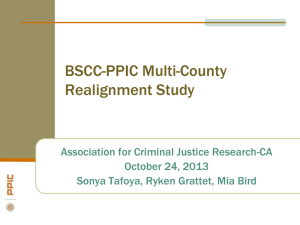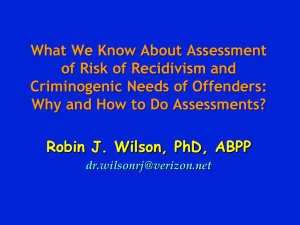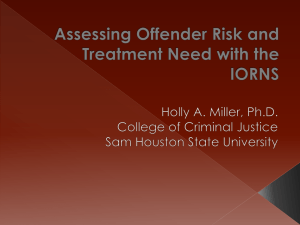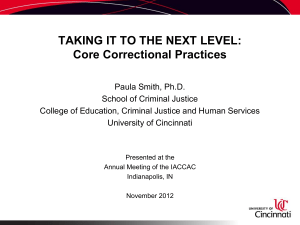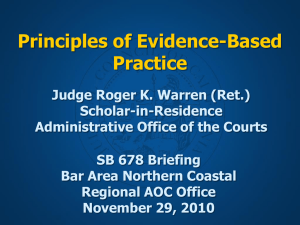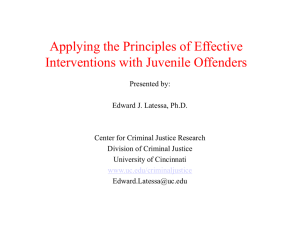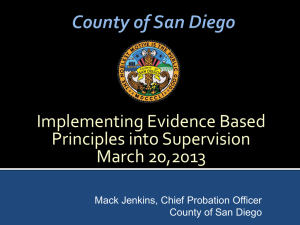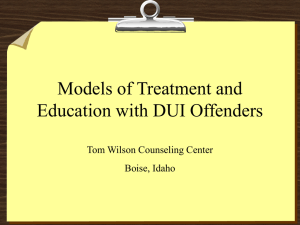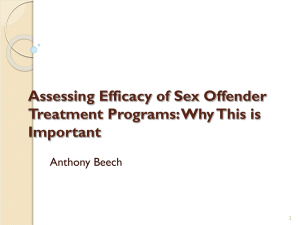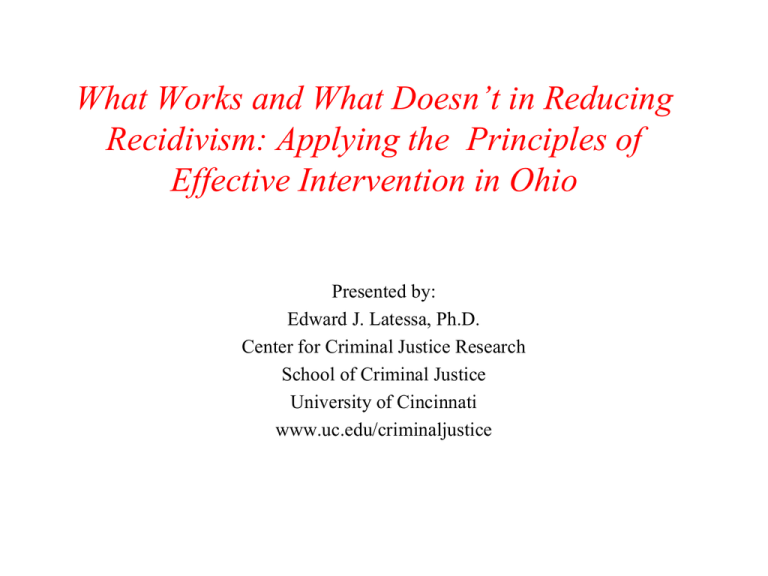
What Works and What Doesn’t in Reducing
Recidivism: Applying the Principles of
Effective Intervention in Ohio
Presented by:
Edward J. Latessa, Ph.D.
Center for Criminal Justice Research
School of Criminal Justice
University of Cincinnati
www.uc.edu/criminaljustice
Purpose of Criminal Sanctions
• Retribution: punishment is justified simply because a person
has broken the law
• General Deterrence: sanction deters potential offenders by
inflicting suffering on actual ones
• Specific Deterrence: sanction is applied to stop to offender
from reoffending again
• Restoration: crime control lies primarily in the community,
and victims should be central to the process of restoration
• Incapacitation: limits offender’s ability to commit another
crime
• Rehabilitation: change in behavior of the offender produced by
treatment and services. Offender chooses to refrain from new
crimes rather than being unable to.
Deterrence Theory
An Exercise in Social Psychology
Aware of the sanction
Perceive it as unpleasant
Weigh the cost and benefits
Assess the risk
Make a rational choice
BUT…Most Street Level Offenders
Impulsive
Short term perspective
Disorganized
Failed in school, jobs, etc.
Distorted thinking
Hang around with others like themselves
Use drugs & alcohol
Not rational actors
In short:
- Deterrence theory collapses
Incapacitation
• Stronger with some type of offenders
(i.e. bank robbers--virtually no effect
with drug dealers or users)
• High cost for relatively low pay off
• Effects are more short term
People Who Appear to be Resistant
to Punishment
• Psychopathic risk takers
• Those under the influence of a substance
• Those with a history of being punished
Evidence Based – What does it mean?
There are different forms of evidence:
– The lowest form is anecdotal evidence; stories,
opinions, testimonials, case studies, etc - but it
often makes us feel good
– The highest form is empirical evidence –
research, data, results from controlled studies,
etc. - but sometimes it doesn’t make us feel
good
Evidence Based Practice is:
1. Easier to think of as Evidence Based Decision
Making
2. Involves several steps and encourages the use of
validated tools and treatments.
3. Not just about the tools you have but also how you
use them
How To Digest This Information
1.Think in terms of own agency
2.Think in terms of outside agencies
3.Think in terms of a system perspective
Evidence Based Decision Making Requires
1. Assessment information
2. Relevant research
3. Available programming
4. Evaluation
5. Professionalism and knowledge from staff
What does the Research tell us?
There is often a Misapplication of Research: “XXX Study
Says”
- the problem is if you believe every study we wouldn’t eat
anything (but we would drink a lot of red wine!)
• Looking at one study can be a mistake
• Need to examine a body of research
• So, what does the body of knowledge about correctional
interventions tell us?
A Large Body of Research Has
Indicated….
….that correctional services and interventions can be
effective in reducing recidivism for offenders, however,
not all programs and interventions are equally effective
• The most effective approaches are based on some principles of effective
interventions
• Risk (Who)
• Need (What)
• Treatment (How)
• Program Integrity (How Well)
Let’s Start with the Risk Principle
Risk refers to risk of reoffending and
not the seriousness of the offense.
You can be a low risk felon or a high
risk felon, a low risk misdemeanant
or a high risk misdemeanant.
There are Three Elements to the
Risk Principle
1. Target those offenders with higher
probability of recidivism
2. Provide most intensive treatment to higher
risk offenders
3. Intensive treatment for lower risk offender
can increase recidivism
#1: Targeting Higher Risk
Offenders
• It is important to understand that even with
EBP there will be failures.
• Even if you reduce recidivism rates you will
still have high percentage of failures
Example of Targeting Higher Risk Offenders
• If you have 100 High risk offenders about
60% will fail
• If you put them in well designed EBP for
sufficient duration you may reduce failure
rate to 40%
• If you have 100 low risk offenders about
10% will fail
• If you put them in same program failure rate
will be 20%
Targeting Higher Risk Offenders
continued:
• In the end, who had the lower recidivism
rate?
• Mistake we make is comparing high risk to
low risk rather than look for treatment
effects
#2: Provide Most Intensive Interventions
to Higher Risk Offenders
• Higher risk offenders will require much higher
dosage of treatment
–
–
–
–
Rule of thumb: 100 hours for moderate risk
200+ hours for higher risk
100 hours for high risk will have little if any effect
Does not include work/school and other activities
that are not directly addressing criminogenic risk
factors
Intensive Treatment for Low Risk Offenders
will Often Increase Failure Rates
• Low risk offenders will learn anti social
behavior from higher risk
• Disrupts prosocial networks
Study of Intensive Rehabilitation Supervision in Canada
Recidivism
Rates
Bonta, J et al., 2000. A Quasi-Experimental Evaluation of an Intensive Rehabilitation Supervision Program., Vol. 27 No 3:312-329. Criminal
Justice and Behavior
2002 STUDY OF COMMUNITY
CORRECTIONAL PROGRAMS IN OHIO
• Largest study of community based correctional treatment
facilities ever done
• Total of 13,221 offenders – 37 Halfway Houses and 15
Community Based Correctional Facilities (CBCFs) were
included in the study.
• Two-year follow-up conducted on all offenders
• Recidivism measures included new arrests & incarceration in
a state penal institution
• We also examined program characteristics
Determination of Risk
• Each offender was given a risk score based
on 14 items that predicted outcome.
• This allowed us to compare low risk
offenders who were placed in a program to
low risk offenders that were not, high risk to
high risk, and so forth.
Reduced
Recidivism
Increased
Recidivism
-4
-19
-20
-10-10
-11
-12
-6
-7
-10
-1 -1
-2
-3
1 1 1
0
4 4
3 3
2
11 11
10 10
9
10
7
6
5 5
0
-14-14
-23-23
Probability of Reincarceration
Treatment Effects for Low/Moderate Risk Offenders
20
-30
-40
-36
)
’s
en
(M
am
gr
ro
RC nt P y
TM me r m
se ss n A
ou se io
H As vat
na ty al
i
n
n
ria n t S
tio
a
O u h
m
ia er
m Lig
km
oc nt
ee
ss Ce
Co or
B
b
A
t
e
ar
n s en
H A us
o
m
m
i
PT H o
ra
ct eat
og
SE er t
rre r
T
Pr
lb H Co ty
y
Ta RT ty ni
nc
k
O n i mu
de
W mu om ty ree ove pen
m C n C r e
Co ton Cou lum g G al D
n n A in ic
Ca li se pr m
k
S
e
an o u e h
Fr is H ous A C
l
al
lv H O
H
A er t V
ng
lb ati
ni
Ta inn
un
D
nc
Ci CC use s
C o m
SR is H gra
lv r o
A ll P ties y
a ili nt
Sm Fac ou
ll t C
A mi ug RIP
m r
e
Su p D u s
s
m Ho
tie
Co na
ili
ria P c
O CA Fa
EO CF y
N CB unt
ll o
A sC
ca
Lu r
ne
tle
sto
Bu C
er
C y
rn
EO da OA Co
on V e
M o us
d
le Ho a m
n
To ert di gu ns
l
o
al
lb Me kin iti
H
Ta ain/ us rans
n
r /M T
ho
Lo ing ity nty Ma
ck n ou c
Li mu g C A M
m in O y
Co on ti V enc
ah a g
M cinn ve A
n ti
Ci rna y
lte it
A er C r t
v ta
Ri h S
es
Fr
-26
-28
-30
-7 -6
-10
1
1
1
1
0
5
5
5
4
4
3
2
9
8
8
6
6
6
10
6
12 13 13
9 10
0
-2 -1
-14 -13
-20
-20
Probability of Reincarceration
Treatment Effects for Moderate Risk Offenders
30
18 19
20
-40
y ion
rm at
A ci
n so
io s
at A
lv ns
Sa tio
h t ec
ig orr C
rL C R
bo ity M
k
ar n e T
ee
H mu u s
Cr
m Ho
m
Co a
u
n
l
)
A
ria
’s
O TA se
en
P u
o
(M
SE s H g y
u
i
t
am er
lv r n
gr nt
A p D ou ty
ro Ce
m n C un
t P nt
Co kli Co
en me
an ng
sm at
Fr oni A ses re
T
O
m
ah V As ty
ra
i
M o
y
n
d
t
og
le ni mu s
Pr
y
To mu m tie
nc
m Co cili
de
Co on Fa
en
nt H
ep
Ca W
D
H
al
ll
ic
A
s m
CC
m he
EO CC gra A C
ve
C ro O
ro
SR ll P i V y g G
a at nt in
Sm inn ou pr
nc t C e S
Ci mi us
l
m Ho
al
H
Su ert
g
lb
y in
Ta er unt unn an
tl o D km
Bu as C se Bee
c ou e
Lu is H ous IP
lv H e R
A er t o u s
lb H
Ta na
ria H
s
O T es
i
R
on
O ilit
iti
W ac
ns
F
P ra m
ll
A CA ity T ngu
l
al
EO n ki
H
N u s
u
m
on
m /M
ah
Co ing
M e
ck
na c n
Li day edi A M rsto
on M O ne
M in/ i V Cor
ra at e y
Lo inn ous nc
nc H ge
Ci ert e A
lb tiv
Ta rna rt
lte ta
A hS
es ity
Fr r C
ve
Ri
20
-6 -5
-10
-18
-20
5
3
3
3
2
9 10 10
8
8
7
6
10
15
12 12 12 13 13 13
0
-2 -2
-15 -14
Probability of Reincarceration
Treatment Effects For High Risk Offenders
40
21 22
24 25
27
30
34
32
30
-30
-40
-34
n
tio
ia
y
oc
nt
ss
A
ou
s
CC C
on y
g
m
i
r
t
n
m
EO ni A rec A
o
n
ra
ah VO or tio
og
M do y C lva
Pr
y
le nit Sa
nc
To m u g h t
de
an
m i
m
en
L
Co or g eek eek ep
D
b
ar ru B Cr l
H p D use m ica
m Ho lu em
Co ert se A Ch
lb u A C
o
Ta s H VO MR
i
i
lv at T
A inn use
nc o s
Ci na H gram
ns
ria ro ty io
O ll P oun nsit
a C ra
Sm klin ty T
an ni
Fr mu
m
C o TA
P
ty
SE r
un um
tle Co ing
r
te
Bu mit usk
en
m /M
tC
Su ing es
en
i
ck lit
tm
Li aci
ea
F
Tr
ll
A CC nty nity
C u u
o
SR C m ies
s
m
t
ca Co ili
l
al
Lu on Fac
H
nt F a ng
Ca BC din nni
C
e
u
ll
A in/M se D IP
e
r a ou R
ov all
r
Lo s H use
G H
i
o
n
g
lv
)
rin aho
A aH
’s
p
n
en
ria P S cM
O CA use M
(M
o
EO H A
am
N ert VO
gr
ro
lb ati
tP
Ta inn
en e
nc
sm n
C i R TH
es to
ss ers
O
W day ty A orn
on ni C
M mu use ncy
m Ho ge
C o er t e A
lb iv
Ta rnat t
lte ar
A h St
es ity
Fr r C
ve
Ri
2010 STUDY OF COMMUNITY
CORRECTIONAL PROGRAMS IN OHIO
• Over 20,000 offenders – 44 Halfway Houses and 20
Community Based Correctional Facilities (CBCFs) were
included in the study.
• Two-year follow-up conducted on all offenders
-60
Harbor Light--D/A
CompDrug
MONDAY
Oriana RIP
Oriana CCTC
West Central
CATS male RTP
TH Turtle Creek
Cinti VOA SOT
AH Alum Creek
Harbor Light--Corr
Alternatives
Franklin
STARK
WORTH
CTCC Canton
NEOCAP
Oriana TMRC
TH Springrove
Oriana Summit
Pathfinder
Oriana Cliff Skeen
ALL CBCF FACILITIES
EOCC Female
ALL HWH FACILITIES
Lorain-Medina
Mahoning
Oriana Crossweah
River City
STAR
Talbert House CCC
Booth H/Salv A
CCA RTC I
CCA RTC II
Cinti VOA D/A
Comm Trans Ctr
Crossroads
Diversified
Fresh Start
SOS
TH Pathways
AH Dunning
ARCA
Oriana RCC
Licking-Muskingum
CATS female RTP
Mansfield VOA
SEPTA
TH Cornerstone
EOCC Male
Lucas
AH Price
AH Veterans
Dayton VOA
Small Programs
Toledo VOA
Northwest CCC
TH Beekman
CATS male TC
% Difference in Rate of New Felony Conviction
Treatment Effects for Low Risk: New Felon Conviction
60
50
40
30
20
10
0
-10
-20
-30
-40
-50
-60
Oriana Crossweah
Licking-Muskingum
West Central
SOS
AH Dunning
STAR
Crossroads
Lucas
ARCA
CTCC Canton
SEPTA
River City
Comm Trans Ctr
MONDAY
Small Programs
AH Price
TH Turtle Creek
Franklin
Oriana Summit
ALL CBCF FACILITIES
Oriana RCC
TH Beekman
Northwest CCC
NEOCAP
Talbert House CCC
EOCC Female
CATS female RTP
Pathfinder
TH Springrove
EOCC Male
CCA RTC I
AH Veterans
Oriana CCTC
Cinti VOA D/A
WORTH
Mansfield VOA
Dayton VOA
TH Cornerstone
Mahoning
ALL HWH FACILITIES
Cinti VOA SOT
Lorain-Medina
Oriana TMRC
CompDrug
Oriana RIP
CATS male TC
Oriana Cliff Skeen
STARK
CATS male RTP
Alternatives
AH Alum Creek
Diversified
Harbor Light--D/A
Booth H/Salv A
Toledo VOA
TH Pathways
Fresh Start
Harbor Light--Corr
CCA RTC II
% Difference in Rate of New Felony Conviction
Treatment Effects for Moderate Risk: New Felony Conviction
60
50
40
30
20
10
0
-10
-20
-30
-40
-50
-60
AH Veterans
TH Beekman
MONDAY
CTCC Canton
TH Springrove
Northwest CCC
WORTH
Diversified
Oriana CCTC
Oriana Summit
Oriana Crossweah
ARCA
Booth H/Salv A
CATS male RTP
Crossroads
Franklin
Comm Trans Ctr
STARK
River City
Talbert House CCC
West Central
EOCC Male
ALL CBCF FACILITIES
CompDrug
AH Dunning
Alternatives
CCA RTC II
Small Programs
Harbor Light--D/A
ALL HWH FACILITIES
Oriana TMRC
CATS male TC
Fresh Start
Dayton VOA
NEOCAP
Harbor Light--Corr
Oriana RIP
Licking-Muskingum
Mahoning
Cinti VOA D/A
Oriana RCC
STAR
SOS
Lucas
CATS female RTP
AH Price
TH Turtle Creek
Lorain-Medina
Pathfinder
Toledo VOA
EOCC Female
Oriana Cliff Skeen
SEPTA
AH Alum Creek
Mansfield VOA
TH Cornerstone
CCA RTC I
% Difference in Rate of New Felony Conviction
Treatment Effects for High Risk: New Felony Convictions
60
50
40
30
20
10
0
-10
-20
-30
-40
-50
Average Difference in Recidivism by Risk for
Halfway House Offenders
Low risk
↑ recidivism by 3%
Moderate risk
↓ recidivism by 6%
High risk
↓ recidivism by 14%
Need Principle
By assessing and targeting criminogenic needs for change,
agencies can reduce the probability of recidivism
Criminogenic
Non-Criminogenic
•
•
•
•
•
•
•
•
•
•
Anti social attitudes
Anti social friends
Substance abuse
Lack of empathy
Impulsive behavior
Anxiety
Low self esteem
Creative abilities
Medical needs
Physical conditioning
Major Set of Risk/Need Factors
1.
Antisocial/procriminal attitudes, values, beliefs and cognitive
emotional states
2.
Procriminal associates and isolation from anticriminal others
3.
Temperamental and anti social personality patterns conducive
to criminal activity including:
Weak socialization
Impulsivity
Adventurous
Restless/aggressive
Egocentrism
A taste for risk
Weak problem-solving/self-regulation & coping skills
4. A history of antisocial behavior
Major Set of Risk/Need Factors Cont.
5.
Familial factors that include criminality and a variety of
psychological problems in the family of origin including:
Low levels of affection, caring, and cohesiveness
Poor parental supervision and discipline practices
Outright neglect and abuse
6.
Low levels of personal, educational, vocational, or financial
achievement
7.
Low levels of involvement in prosocial leisure activities
8.
Substance Abuse
Recent study of parole violators in Pennsylvania found a
number of criminogenic factors related to failure*
*Conducted by Pennsylvania Dept. of Corrections
Pennsylvania Parole Study
Social Network and Living Arrangements
Violators Were:
• More likely to hang around with individuals
with criminal backgrounds
• Less likely to live with a spouse
• Less likely to be in a stable supportive
relationship
• Less likely to identify someone in their life
who served in a mentoring capacity
Pennsylvania Parole Study
Employment & Financial Situation
Violators were:
• Slightly more likely to report having difficulty getting a
job
• Less likely to have job stability
• Less likely to be satisfied with employment
• Less likely to take low end jobs and work up
• More likely to have negative attitudes toward
employment & unrealistic job expectations
• Less likely to have a bank account
• More likely to report that they were “barely making it”
(yet success group reported over double median debt)
Pennsylvania Parole Study
Alcohol or Drug Use
Violators were:
• More likely to report use of alcohol or drugs
while on parole (but no difference in prior
assessment of dependency problem)
• Poor management of stress was a primary
contributing factor to relapse
Pennsylvania Parole Study
Life on Parole
Violators were:
• Had unrealistic expectations about what life would be
like outside of prison
• Had poor problem solving or coping skills
– Did not anticipate long term consequences of behavior
• Failed to utilize resources to help them
– Acted impulsively to immediate situations
– Felt they were not in control
• More likely to maintain anti-social attitudes
– Viewed violations as an acceptable option to situation
– Maintained general lack of empathy
– Shifted blame or denied responsibility
Pennsylvania Parole Violator Study:
• Successes and failures did not differ in
difficulty in finding a place to live after
release
• Successes & failures equally likely to report
eventually obtaining a job
Major Risk and/or Need Factor and Promising Intermediate
Targets for Reduced Recidivism
Factor
Risk
Dynamic Need
History of Antisocial
Behavior
Early & continued
involvement in a number
antisocial acts
Build noncriminal
alternative behaviors
in risky situations
Antisocial personality
Adventurous, pleasure
Build problem-solving, selfseeking, weak self
management, anger mgt &
control, restlessly aggressive coping skills
Antisocial cognition
Attitudes, values, beliefs
& rationalizations
supportive of crime,
cognitive emotional states
of anger, resentment, &
defiance
Antisocial associates
Close association with
Reduce association w/
criminals & relative isolation criminals, enhance
from prosocial people
association w/ prosocial people
Reduce antisocial cognition,
recognize risky thinking &
feelings, build up alternative
less risky thinking & feelings
Adopt a reform and/or
anticriminal identity
Adopted from Andrews, D.A. et al, (2006). The Recent Past and Near Future of Risk and/or Need Assessment. Crime and Delinquency, 52 (1).
Major Risk and/or Need Factor and Promising Intermediate
Targets for Reduced Recidivism
Factor
Risk
Dynamic Need
Family and/or marital
Two key elements are
nurturance and/or caring
better monitoring and/or
supervision
Reduce conflict, build
positive relationships,
communication, enhance
monitoring & supervision
School and/or work
Low levels of performance
& satisfaction
Enhance performance,
rewards, & satisfaction
Leisure and/or recreation
Low levels of involvement
& satisfaction in anticriminal leisure activities
Enhancement involvement
& satisfaction in prosocial
activities
Substance Abuse
Abuse of alcohol and/or
drugs
Reduce SA, reduce the
personal & interpersonal
supports for SA behavior,
enhance alternatives to SA
Adopted from Andrews, D.A. et al, (2006). The Recent Past and Near Future of Risk and/or Need Assessment. Crime and Delinquency, 52 (1).
Targeting Criminogenic Need: Results from MetaAnalyses
Reduction in
Recidivism
Increase in
Recidivism
Source: Gendreau, P., French, S.A., and A.Taylor (2002). What Works (What Doesn’t Work) Revised 2002. Invited Submission to the International Community Corrections
Association Monograph Series Project
Assessment is the engine that drives
effective correctional programs
• Need to meet the risk and need principle
• Reduces bias
• Aids decision making
• Allows you to target dynamic risk factors
and measure change
According to the American Heart Association, there are a number of
risk factors that increase your chances of a first heart attack
Family history of heart attacks
Gender (males)
Age (over 50)
Inactive lifestyle
Over weight
High blood pressure
Smoking
High Cholesterol level
The Development and Validation of the
Ohio Risk and Need
Assessment System (ORAS)
Project Overview
• The Ohio Risk Assessment System (ORAS)
consists of four major instruments:
1.
2.
3.
4.
Pretrial
Community Supervision
Prison Intake
Reentry
Data Collection
• Data collection for primary data was collected
by UC research staff with structured
interviews, file reviews, and self-report
surveys
• Recidivism data was collected by online court
records by county of arrest as well as OHLEG
• Total Sample was 1,837 from across Ohio
Domains Examined
1.
2.
3.
4.
5.
6.
7.
8.
9.
10.
Pro-criminal views/criminal thinking
Friends and criminal acquaintances
Education
Family and social relationships
Residence stability and safety
Alcohol abuse/use
Drug abuse/use
Mental and physical health
Employment (status and values)
Criminal history
Domains Examined
11. Financial stress
12. Involvement in pro-social activities
13. Physical and sexual abuse
14. Problem recognition
15. Treatment motivation, needs, expectations
16. Anxiety/negative emotionality
17. Empathy/perspective taking
18. Coping skills/values
19. Anger/frustration
The Pretrial Instrument
• First entry into the ORAS system
• Outcome indicator included Failure to Appear and
New Arrest
PRETRIAL ASSESSMENT TOOL
NAME: _____________________________________
CASE NUMBER:_____________________________
BOND AMOUNT:____________________________
DATE OF OFFENSE:______________
DATE OF ASSESSMENT:__________
COURT DATE:___________________
Verified
1. What was the age of the defendant at first arrest. If unknown, use first conviction
0 = If the defendant was 33 or older
1 = If the defendant was 32 or younger
2. How many failure to appear warrants have been filed in the last 24 months
0 = None
1 = A single failure to appear in the last 24 months
2 = Two or more failure to appears in the last 24 months
3. Did the defendant have three or more prior jail incarcerations?
0 = No
1 = Yes
Number of Prior Prison incarcerations: ______
4. Was the defendant employed at the time of arrest?
0 = Defendant is employed full time/disabled/retired/student (31+ hours)
1 = Defendant is employed part time (10-30 hours)
2 = Defendant is unemployed
Defendant on public welfare?: ______
Job start date was within 6 months: ______
5. Any illegal drug use in the last 6 months
0 = No
1 = Yes
6. Defendant self reported severe drug related problems
0 = No (1-3)
1 = Yes (4-5)
7. Has the Defendant lived at the current residence for 6 months or more?
0 = Yes
1 = No
Is the current residence within the assessor’s jurisdiction? ______
Risk Level
0-2 = Low
3-5 = Medium
6+ = High
TOTAL SCORE
Cutoffs Scores
• The descriptive statistics revealed that there were
very few high risk cases, indicating that the
cutoffs should be adjusted to provide better
representation for all groups
• Revised cutoffs and percentages
N
%
Low: 0-2
Medium: 3-5
High: 6+
126
239
87
28
53
19
Cutoffs
Failure to Appear
New Arrest
14.9
16
14
12
10
8
6
4
2
0
6.7
0
Low
r = .128
Medium
r = .206
High
Cutoffs: Any Violation
Failure Rate of Sample
35
28.7
30
25
20
17.6
LOW
MED
15
HIGH
10
5
4.8
0
Differences in Recidivism Rates for each Risk Level
(r = .223, n=452)
Community Supervision Risk
Assessment Tool (ORAS-CST)
Final Domains on the ORAS-CST
1.
2.
3.
4.
5.
6.
7.
Criminal /Supervision History (6 items)
Education, Employment and Finances(6 items)
Family and Social Support (5 items)
Neighborhood Problems (2 items)
Substance Use (5 items)
Peer Associations (4 items)
Criminal Attitudes and Behavioral Problems (7 items)
The Distribution of Risk Levels for Males in the
Community Supervision Sample
Males (N = 513)
Level
N
%
Low Risk (0-14)
77
15
Medium Risk (15-23)
207
40
High Risk (24-33)
190
37
Very High Risk (34+)
39
8
Percent with New Arrest
Males: Risk Level by Recidivism for the Community
Supervision Sample
Low 0-14
Medium = 15-23
High = 24-33
Very High 34+
ORAS-CST Risk Level Correlation with Recidivism: r = .373
The Distribution of Risk Levels for Females in the
Community Supervision Sample
Females (N =165)
Level
N
%
Low Risk (0-14)
43
25
Medium (15-21)
65
40
High Risk (22-28)
47
29
Very High Risk (29+)
10
6
Females: Risk Level by Recidivism for the Community
Supervision Sample
60
Low Risk
Medium Risk
High Risk
Very High Risk
50
Percent with New Arrest
50
40.4
40
30
21.5
20
10
9.3
0
Low 0-14
Medium 15-21
High 22-28
Very High 29+
ORAS-CST Risk Level Correlation with Recidivism: r = .300
Additional Case Planning Items
• Additional case planning items are incorporated into the
final assessment.
– These items are asked of the offender but the answers are used for case
planning purposes and to facilitate targeting responsivity obstacles but
which are not used in the final calculation for the prediction of adult
criminal recidivism and/or probation violations.
• These include questions pertaining to:
Low intelligence
Reading and writing limitations
History of abuse/neglect
Transportation
Language
Physical handicap
Mental health issues
Treatment motivation
Child care
Ethnicity, and cultural barriers
Priorities in Case Management
• Each domain provides cut points that
indicate the priority the domain should take
in service provision.
• Individuals who score high have high
deficits in these categories and are more
likely to re-offend.
Priorities in Case Management
Criminal History
60
Low Priority Medium Priority High Priority
46
50
53
60
Low Priority Medium Priority High Priority
50
37
40
40
30
Education and Finances
30
27
20
20
10
10
0
0
21
Percent Arrested by Priority Level
Percent Arrested by Priority Level
Low (0-3)
Med (4-6)
High (7-8)
Low (0-1)
Med (2-4)
High (5-6)
55
Priorities in Case Management
Family and Social Support
Neighborhood Problems
60
40
48
41
30
20
10
0
Percent Arrested
Percent Arrested
50
Low Priority
Medium Priority
High Priority
32
50
45
40
35
30
25
20
15
10
5
0
45
Low Priority
Medium Priority
High Priority
35
17
Percent Arrested by Priority Level
Percent Arrested by Priority Level
Low (0-1)
Med (2-3)
High (4-5)
Low (0)
Med (1)
High (2-3)
Priorities in Case Management
50
45
40
35
30
25
20
15
10
5
0
Low Priority
Medium Priority
High Priority
27
Peers
70
45
40
60
Percent Arrested
Percent Arrested
Substance Abuse
50
64
Low Priority
Medium Priority
High Priority
43
40
30
21
20
10
0
Percent Arrested by Priority Level
Percent Arrested by Priority Level
Low (0-2)
Med (3-4)
High (5-6)
Low (0-1)
Med (2-4)
High (5-8)
Priorities in Case Management
Criminal Attitudes and Behavior Patterns
70
Percent Arrested
60
50
Low Priority
Medium Priority
High Priority
59
44
40
30
24
20
10
0
Percent Arrested by Priority Level
Low (0-3)
Med (4-8)
High (9-13)
Screening Tool (ORAS-CSST)
• ORAS-CSST
– Abbreviated version of the ORAS-CST
• Designed to quickly identify low risk offenders who
may not need case management priorities and a full
assessment.
– 4 Items taken from the ORAS-CST
– Scores range from 0 - 7
– Overall Correlation with new arrest: r =.381
The Distribution of Risk Levels for Males with the
Community Supervision Screen
Males (N = 513)
Level
N
%
Low (0-2)
119
23.2
Medium - High (3-7)
394
76.8
Males: Risk Level by Recidivism for the Community
Supervision Screen
Percent with New Arrest
60
Low Risk
Med-High Risk
50.3
50
40
30
20
16
10
0
Low 0-2
Med – High Risk (3-7)
ORN-CS Screen Score Correlation with Recidivism: r = .372
The Distribution of Risk Levels for Females with
the Community Supervision Screen
Females (N =165)
Level
N
%
Low Risk (0-3)
88
53
Medium - High (4-7)
77
47
Females: Risk Level by Recidivism for the Community
Supervision Screen
Percent with New Arrest
50
Low Risk
Med-High Risk
40.3
40
30
20
12.5
10
0
Low 0-3
Med – High Risk (4-7)
ORN-CS Screen Score Correlation with Recidivism: r = .365
Prison Reentry Assessment Tool
(ORAS-RT)
Final Domains
1.
2.
3.
Criminal /Supervision History (8 items)
Social Capital and Support (5 items)
Criminal Attitudes and Behavioral Patterns (7 items)
The Distribution of Risk Levels for Males in the
Prison Release Sample
Males (N =212)
Level
N
%
Low Risk (0-9)
47
22
Medium Risk (10-15)
109
52
High Risk (16+)
56
26
Males: Risk Level by Recidivism for the Prison Release
Sample
Percent with New Arrest
70
64.3
60
49.5
50
40
30
21.3
20
10
0
Low 0-9
Medium 10-15
High 16+
ORAS-PRT Risk Level Correlation with Recidivism: r = .295
The Distribution of Risk Levels for Females in the
Prison Release Sample
Females (N =65)
Level
N
%
Low Risk (0-10)
31
48
Medium (11-14)
25
38
High Risk (15+)
9
14
Females: Risk Level by Recidivism for the Prison
Release Sample
Percent with New Arrest
60
55.6
50
44
40
30
20
10
6.5
0
Low 0-10
Medium = 11-14
High = 15+
ORAS-PRT Risk Level Correlation with Recidivism: r = .442
Advantage to ORAS
•
•
•
•
•
•
•
Developed and validated on Ohio population
Assessments at various decision points
Non-proprietary
Will be fully automated
Training and training of trainers available
Can be used for case planning and reassessment
Standardizes assessment across the State
Some Common Problems with Offender
Assessment
Assess offenders but process ignores important factors
Assess offenders but don’t distinguish levels (high,
moderate, low)
Assess offenders then don’t use it – everyone gets the
same treatment
Make errors and don’t correct
Don’t assess offenders at all
Do not adequately train staff in use or interpretation
Assessment instruments are not validated or normed
• List three speeches that have changed your
life
• List three people who have changed your
life
Treatment Principle
The most effective interventions are behavioral:
• Focus on current factors that influence behavior
• Action oriented
Results from Meta Analysis: Behavioral vs.
NonBehavioral
Reduced
Recidivism
Andrews, D.A. 1994. An Overview of Treatment Effectiveness. Research and Clinical Principles, Department of Psychology, Carleton
University. The N refers to the number of studies.
Most Effective Behavioral Models
• Structured social learning where new skills
and behavioral are modeled
• Cognitive behavioral approaches that target
criminogenic risk factors
Social Learning
Refers to several processes through which
individuals acquire attitudes, behavior, or
knowledge from the persons around them. Both
modeling and instrumental conditioning appear to
play a role in such learning
The Four Principles of Cognitive
Intervention
1. Thinking affects behavior
2. Antisocial, distorted, unproductive
irrational thinking can lead to antisocial
and unproductive behavior
3. Thinking can be influenced
4. We can change how we feel and behave by
changing what we think
Recent Meta-Analysis of Cognitive Behavioral Treatment for
Offenders by Landenberger & Lipsey (2005)*
• Reviewed 58 studies:
19 random samples
23 matched samples
16 convenience samples
• Found that on average CBT reduced recidivism by 25%,
but the most effective configurations found more than 50%
reductions
Significant Findings (effects were stronger if):
•
•
•
•
Sessions per week (2 or more) - RISK
Implementation monitored - FIDELITY
Staff trained on CBT - FIDELITY
Higher proportion of treatment completers RESPONSIVITY
• Higher risk offenders - RISK
• Higher if CBT is combined with other services - NEED
Evaluation of a CBT Program:
Thinking for a Change
Lowenkamp and Latessa (2006)
•
•
•
•
•
Tippecanoe County Indiana
Probation +T4C vs. Probation
136 Treatment cases
97 Comparison cases
Variable follow up (range 6 to 64 months;
average 26)
• Outcome—arrest for new criminal behavior
Multivariate Model
• Controlled for
– Risk (prior arrests, prior prison, prior
community supervision violations, history of
drug use, history of alcohol problems, highest
grade completed, employment status at arrest)
– Age
– Sex
– Race
– Time at risk or length of follow up time
Adjusted Recidivism Rates Comparing T4C
Participants to Comparison Group
Recent Study of Non-Residential Community
Correctional Programs in Ohio involving over
13,000 Offenders
• Included both misdemeanants and felons
under community supervision
• Programs included day reporting centers,
work release, ISP, and electronic
monitoring programs
TYPE OF COMMUNITY SUPERVISION PROGRAM DID
NOT MATTER: FOUR FACTORS WERE
SIGNIFCICANTLY RELATED TO OUTCOME
• Proportion of higher risk offenders in program (at least 75% of
offenders in programs were moderate or high risk)
• Level of supervision for higher risk offenders (high risk offenders
averaged longer periods of supervision than low risk)
• More treatment for higher risk offenders (at least 50% more time spent
in treatment)
• More referrals for services for higher risk offenders (at least 3 referrals
for every 1 received by low risk)
Changes in Recidivism by Program
Factors for Probation Programs
Reductions in
Recidivism
Increased
Recidivism
Change in Recidivism by 4 Point Factor Score
for Probation Programs
Reduced
Recidivism
Increased
Recidivism
What Doesn’t Work with Offenders?
Lakota tribal wisdom says that when you discover you are riding a dead
horse, the best strategy is to dismount. However, in corrections, and in
other affairs, we often try other strategies, including the following:
•
•
•
•
•
•
•
•
•
•
•
•
Buy a stronger whip.
Change riders
Say things like “This is the way we always have ridden this horse.”
Appoint a committee to study the horse.
Arrange to visit other sites to see how they ride dead horses.
Create a training session to increase our riding ability.
Harness several dead horses together for increased speed.
Declare that “No horse is too dead to beat.”
Provide additional funding to increase the horse’s performance.
Declare the horse is “better, faster, and cheaper” dead.
Study alternative uses for dead horses.
Promote the dead horse to a supervisory position.
Ineffective Approaches
• Programs that cannot maintain fidelity
• Drug prevention classes focused on fear and other
emotional appeals
• Shaming offenders
• Drug education programs
• Non-directive, client centered approaches
• Bibliotherapy
• Freudian approaches
• Talking cures
• Self-Help programs
• Vague unstructured rehabilitation programs
• Medical model
• Fostering self-regard (self-esteem)
• “Punishing smarter” (boot camps, scared straight, etc.)
The Fidelity Principle: Make Sure Programs
Are Delivered With Fidelity and Integrity
Program Integrity and Recidivism
• Every major study we have done has found
a strong relationship between program
integrity and recidivism
• Higher integrity score – greater the
reductions in recidivism
Program Integrity—Relationship Between Program Integrity Score
And Treatment Effect for Community Supervision Programs
Reduced
Recidivism
Increased
Recidivism
Program Integrity—Relationship Between Program Integrity Score
And Treatment Effect for Residential Programs
Reduced
Recidivism
Increased
Recidivism
0-30
31-59
60-69
70+
Lessons Learned from the Research
Who you put in a program is important –
pay attention to risk
What you target is important – pay attention
to criminogenic needs
How you target offender for change is
important – use behavioral approaches
Important Considerations
Offender assessment is the engine that drives
effective programs
helps you know who & what to target
Design programs around empirical research
helps you know how to target offenders
Program Integrity make a difference
Service delivery, disruption of criminal
networks, training/supervision of staff,
support for program, QA, evaluation

